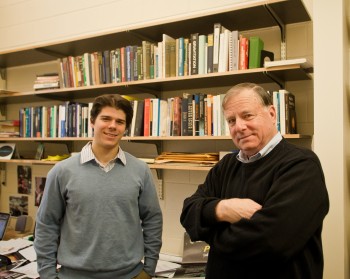From Classics to Cosmology

Emeritus Professor of Astronomy Bruce Partridge (right) with Ben Walter '13, a Classics major who has been helping him edit scientific papers describing the findings of the Planck space telescope.
Details
It was big news for cosmology—and front-page news in the New York Times—in March when the European Space Agency released the first significant batch of data from the Planck space telescope, which has been surveying the sky since its launch in 2009. That data included an image (based on the initial 15.5 months of Planck data) of the cosmic microwave background, or CMB, which is the radiation left over from the Big Bang. The most detailed map ever created of the CMB, it is already challenging previous ideas about the age of the universe, the rate at which it is expanding and what it is made of.
Avidly awaiting the big reveal here on campus were Emeritus Professor of Astronomy Bruce Partridge and Haverford College senior Ben Walter, who may be the sole undergraduate to play a role in the Planck research.
Partridge, who has been studying the cosmic microwave background for more than 40 years and helped write the original Planck proposal back in the 1990s, first hired Walter in the summer of his freshman year. His job: to assist Partridge in a close reading of papers written by members of the Planck Scientific Collaboration. (In conjunction with the public announcement in March about the findings thus far, the Planck project also issued more than two dozen papers that describe the new data.)
Partridge, who is a member of Planck's education and public outreach team, describes Walter as his“co-editor,” working to make sure that all of the papers follow a certain style and format, as well as correcting language errors by scientists whose first language is not English.“But he's not just a copy editor,” says Partridge, who was present in French Guiana in May 2009 for the launch of Planck. “Ben has also been doing some of the data analysis.” Among the results of that work: Scientists have been able to use measurements made by Planck to recalibrate ground-based radio telescopes, as recently reported by Walter and Partridge at the first Planck science meeting, held in the Netherlands.
What's most remarkable, perhaps, is that Walter isn't an astronomy student. He's not looking toward a career in science at all. He's a Classics major.
“It was a chance to do something different, and it's been great to learn more about astronomy, which is a topic that has always fascinated me,” says Walter, who grew up just down the road from Haverford, in Wayne, Pa.“It's also been great to see the process of science up close. I think it can be really opaque if you are not doing it.” Another plus:“The basic skills of careful copy editing have been something I've been able to import into my studies.”
Walter, who has been accepted to a master's program in Classics at Oxford University, but is also considering law school, will continue his work with the Planck data this summer during several weeks at the University of Ferrara, near Bologna.“Ben was hired by some Italian colleagues of mine to do much the same thing he has been doing with me, and, in particular, to help with the English,” says Partridge.
“It will be a lot more efficient for me to be there with them,” says Walter of the Italian astronomers who have sought his help.“If I'm not sure about a particular scientific concept in a sentence, it's better to talk to the person to see how you can rewrite it and express things more clearly.”
Partridge's work on the Planck reports will continue after Walter's graduation in May. He has still more scientific papers to edit and will be seeking a new student assistant to help with that.“Planck data are still pouring in and the collection will go on through August,” he says.“There will be another release in a year, and another release after that. People will be using these data for years.”
—Eils Lotozo
.



